3D integrated circuit prototype dedicated to the ... - HAL - IN2P3
3D integrated circuit prototype dedicated to the ... - HAL - IN2P3
3D integrated circuit prototype dedicated to the ... - HAL - IN2P3
You also want an ePaper? Increase the reach of your titles
YUMPU automatically turns print PDFs into web optimized ePapers that Google loves.
2) Shaper description<br />
The shaper has almost <strong>the</strong> same structure than <strong>the</strong><br />
preamplifier with a capacitive coupling but also with an<br />
additional variable gain and a 5 bits DAC <strong>to</strong> adjust <strong>the</strong> DC<br />
output and thus <strong>the</strong> threshold.<br />
Figure 5: shaper schematic<br />
The bias current are Ib1 = 2.5 nA, Ib2 = 5 nA, Ib3 = 60<br />
nA.<br />
The variable gain consist in four various NMOS in parallel<br />
which can be switched leading <strong>to</strong> make <strong>the</strong> global Cgd value<br />
<strong>to</strong> vary. So <strong>the</strong> gain varies from 172 mV/ke- <strong>to</strong> 487 mV/ke-,<br />
or from 1.075 V/fC <strong>to</strong> 3 V/fC.<br />
The DAC fixes <strong>the</strong> output DC voltage.<br />
3) The 5 bits DAC<br />
Since <strong>the</strong> high resistance poly option from Chartered was<br />
not taken, <strong>the</strong> DAC would have been designed with only<br />
transis<strong>to</strong>rs.<br />
Figure 6: 5 bits DAC schematic<br />
The principle of this DAC is not usual: two sets of diodes<br />
have been designed in such a way that <strong>the</strong> equivalent<br />
impedances are different. Four current sources can be selected<br />
445<br />
<strong>to</strong> make <strong>the</strong> current <strong>to</strong> vary. One bit selects <strong>the</strong> diode we want<br />
<strong>to</strong> use; <strong>the</strong> four o<strong>the</strong>r bits adjust <strong>the</strong> current which draws<br />
through <strong>the</strong> selected diode. The DAC value can vary from 460<br />
mV <strong>to</strong> 850 mV which is sufficient for tuning <strong>the</strong> threshold.<br />
4) Discrimina<strong>to</strong>r description<br />
The discrimina<strong>to</strong>r consists of three inverters. At first, this<br />
block should be in<strong>to</strong> <strong>the</strong> digital tier <strong>to</strong> minimize <strong>the</strong> bulk<br />
coupling between <strong>the</strong> discrimina<strong>to</strong>r and <strong>the</strong> preamplifier<br />
input. This design will be made in a next <strong>circuit</strong>.<br />
Discri input<br />
Output of <strong>the</strong> first<br />
inverter<br />
Output of <strong>the</strong><br />
second inverter<br />
Output of <strong>the</strong><br />
third inverter<br />
Vthn = 497 mV<br />
Vthp = - 470 mV<br />
VDD = 1 V<br />
Intrinsic threshold<br />
= 0.5 mV<br />
Figure 7: outputs after <strong>the</strong> three inverters<br />
5) Dedicated test chip<br />
This <strong>circuit</strong> has been design in such a way that it can be<br />
easy <strong>to</strong> test and measure <strong>the</strong> signals.<br />
Three probes have been added in<strong>to</strong> each analogue<br />
channels after <strong>the</strong> preamplifier, <strong>the</strong> shaper and <strong>the</strong><br />
discrimina<strong>to</strong>r <strong>to</strong> observe signals by oscilloscope.<br />
Several column types have been designed allowing us <strong>to</strong><br />
study various flavors of transis<strong>to</strong>r types (normal, low Vt,<br />
3p3), noise, oscillations…<br />
Column 1 <strong>to</strong> 10: reference channels<br />
Column 11 <strong>to</strong> 18: various preamplifier<br />
transis<strong>to</strong>r types have been <strong>integrated</strong><br />
Column 19 <strong>to</strong> 22: without variable gain<br />
Column 23: discrimina<strong>to</strong>r has been removed<br />
Column 24: shaper has been removed




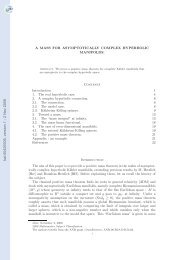
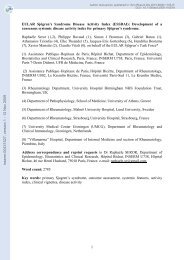
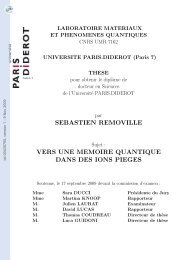
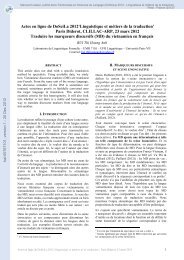
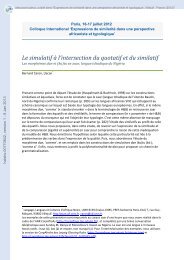
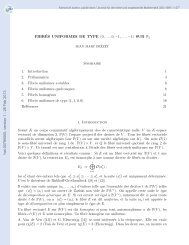
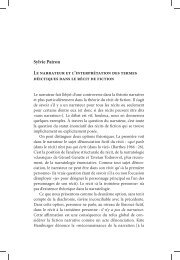
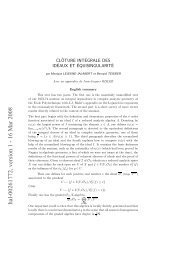
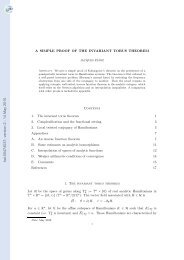

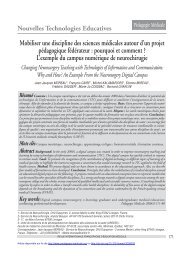

![[tel-00433556, v1] Relation entre Stress Oxydant et Homéostasie ...](https://img.yumpu.com/19233319/1/184x260/tel-00433556-v1-relation-entre-stress-oxydant-et-homeostasie-.jpg?quality=85)